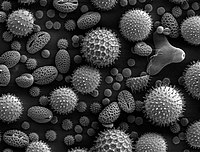
Photo from wikipedia
The relationship between eosinophils/basophils and allergic sensitization is not clear in pediatric adenotonsillar hypertrophy (ATH). The objective of this study is to investigate the relationship between eosinophil/basophil counts and peripheral… Click to show full abstract
The relationship between eosinophils/basophils and allergic sensitization is not clear in pediatric adenotonsillar hypertrophy (ATH). The objective of this study is to investigate the relationship between eosinophil/basophil counts and peripheral specific IgE levels, and identify the common allergens in children with ATH. We initially screened 1,031 consecutive children who underwent adenotonsillectomy in our department from June 2018 to June 2019, and finally included 676 children. The eosinophil count, basophil count, and levels of specific IgE were collected. Correlations between two quantitative variables were assessed using the Pearson or Spearman coefficient. Logistic regression analyses were performed to evaluate the odds ratios (ORs) for atopy after controlling for age, sex, vitamin D, BMI, and visiting season. Both the eosinophil and basophil counts in atopic participants were significantly higher compared to non-atopic participants. The eosinophil count correlated with the levels of IgE specific to all allergens, and eosinophilia was independently associated with all tested atopy allergens other than atopy to dander after multivariate adjustment. Additionally, the basophil count correlated with the IgE levels specific to A. alternate and food mix, and basophilia was still significantly associated with atopy to food mix after multivariable adjustment. Furthermore, among allergic participants, D. farinae was the most prevalent allergen, followed by food mix, D. pteronyssinus, and A. alternata. In conclusion, eosinophils were more relevant to allergic sensitization than basophils, with eosinophils being significantly associated with all tested atopy allergens apart from dander, and basophils being associated with atopy to food mix. Furthermore, D. farinae was the most prevalent allergen and may be indicative of desensitization therapy.
Journal Title: Frontiers in Pediatrics
Year Published: 2021
Link to full text (if available)
Share on Social Media: Sign Up to like & get
recommendations!